Apple M1 Pro Review
Today we're taking our benchmarking to places it's never been earlier with an in-depth look at an Apple Silicon product. A few weeks agone we bought a new Apple tree MacBook Pro sixteen powered by the M1 Pro SoC, and have been putting it through its paces ever since.
So this review is all about benchmarking the new M1 Pro and properly comparing it to the best x86-based CPUs we have today from AMD and Intel. And by properly comparing, we don't mean running Geekbench and calling it a day. In fact, nosotros won't exist running Geekbench at all... we mean running a wide range of real-earth multi-platform applications and comparing performance across the best laptop chips bachelor today, all run nether fair and equivalent weather condition.
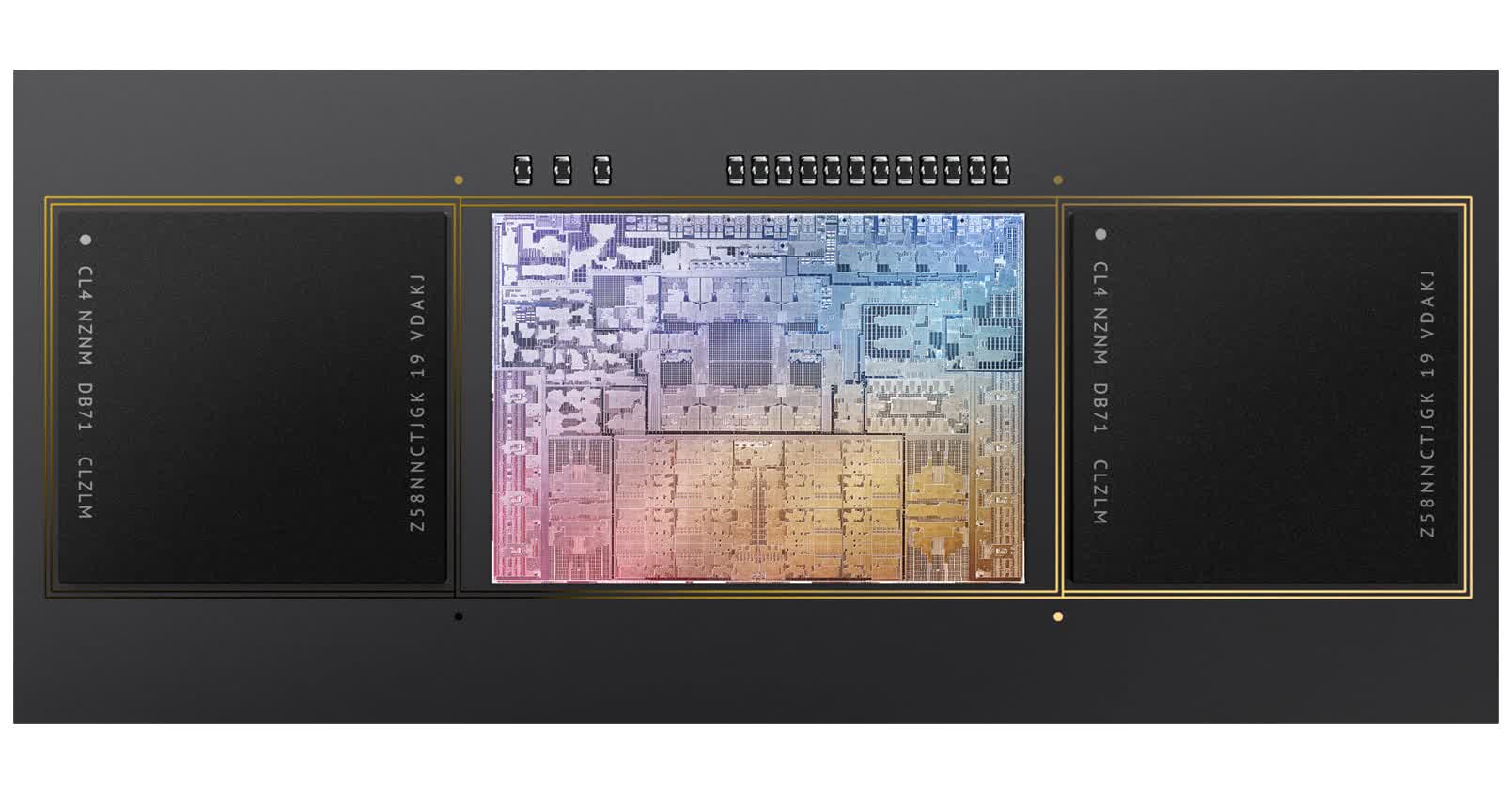
This is going to be interesting because it'due south fair to say there's a lot of hype effectually Apple M1 silicon and its supposed desktop-destroying performance. With hype there'due south often overhype and certainly a lot of fanboyism, including taking Apple tree's in-house benchmarks as gospel, and so nosotros'll see how warranted all of that is today.
The Apple M1 Pro is a very different SoC design to the chips we normally review because it uses the Arm compages family instead of x86. That doesn't hateful it'southward better, it but goes about things in a different way. At the heart of this processor are a maximum of 10 CPU cores, divide into 8 high performance Firestorm cores and two efficient Icestorm cores in a hybrid design. The Firestorm cores are clocked upward to iii.ii GHz and the Icestorm cores hit two.one GHz, though this depends on the corporeality of load in the organization and all-core workloads drop those clocks by a few hundred MHz.
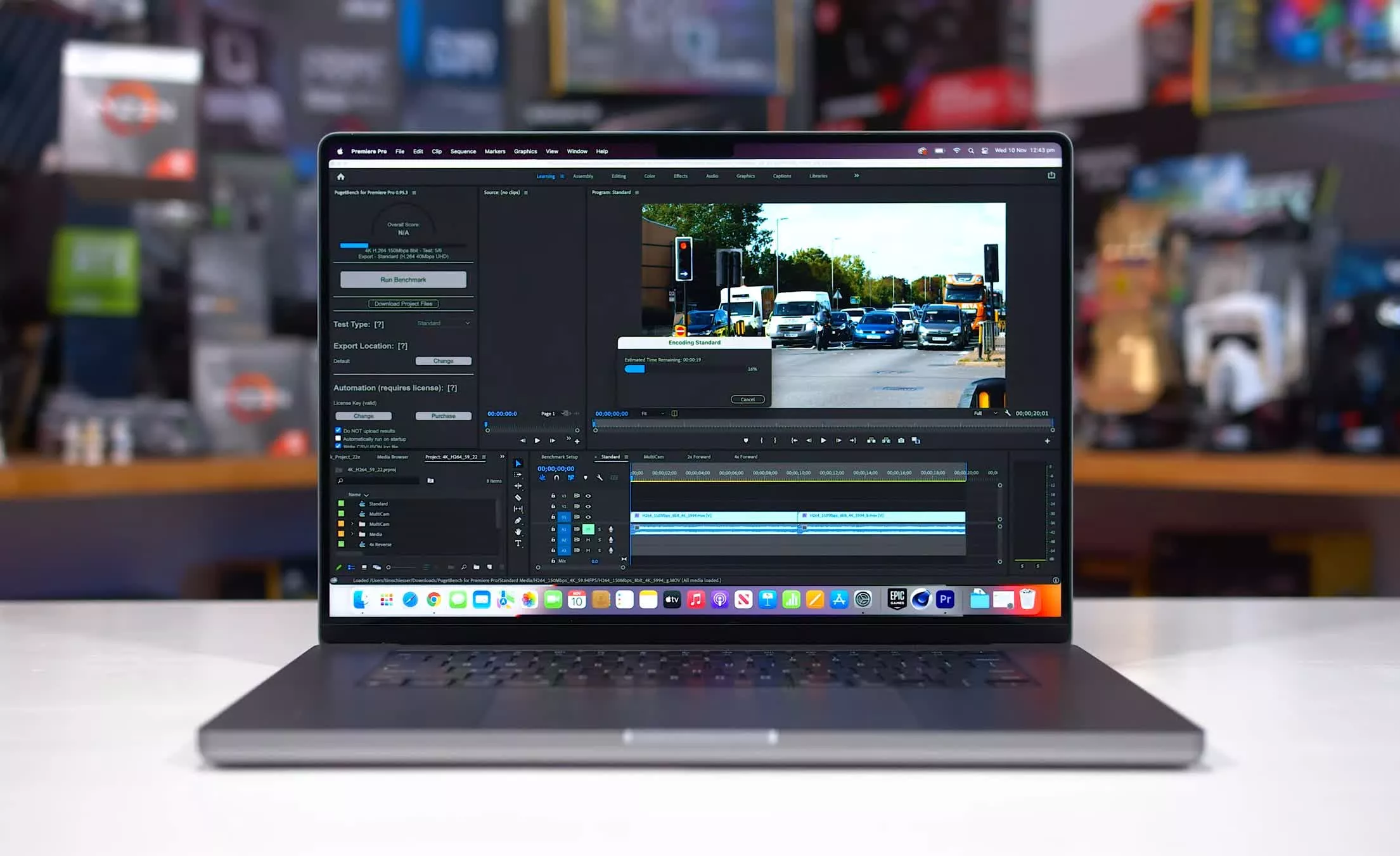
On the GPU side nosotros have a 16-cadre design in the M1 Pro, which goes up to 32 cores in the M1 Max (which is offered in a more expensive version of the same laptop). Continued to the CPU and GPU in a unified design is a 256-flake wide LPDDR5 memory coach providing slightly over 200 GB/s, yous can call up of this like if an x86 design included quad-channel memory instead of dual-channel, it'southward certainly a lot of memory bandwidth and much more than you'd make it similar products from Intel or AMD. There's too lots of L2 cache and 24 MB of peak level enshroud on the M1 Pro. Both the pinnacle level cache and memory controllers are doubled on the M1 Max blueprint to feed the larger GPU.
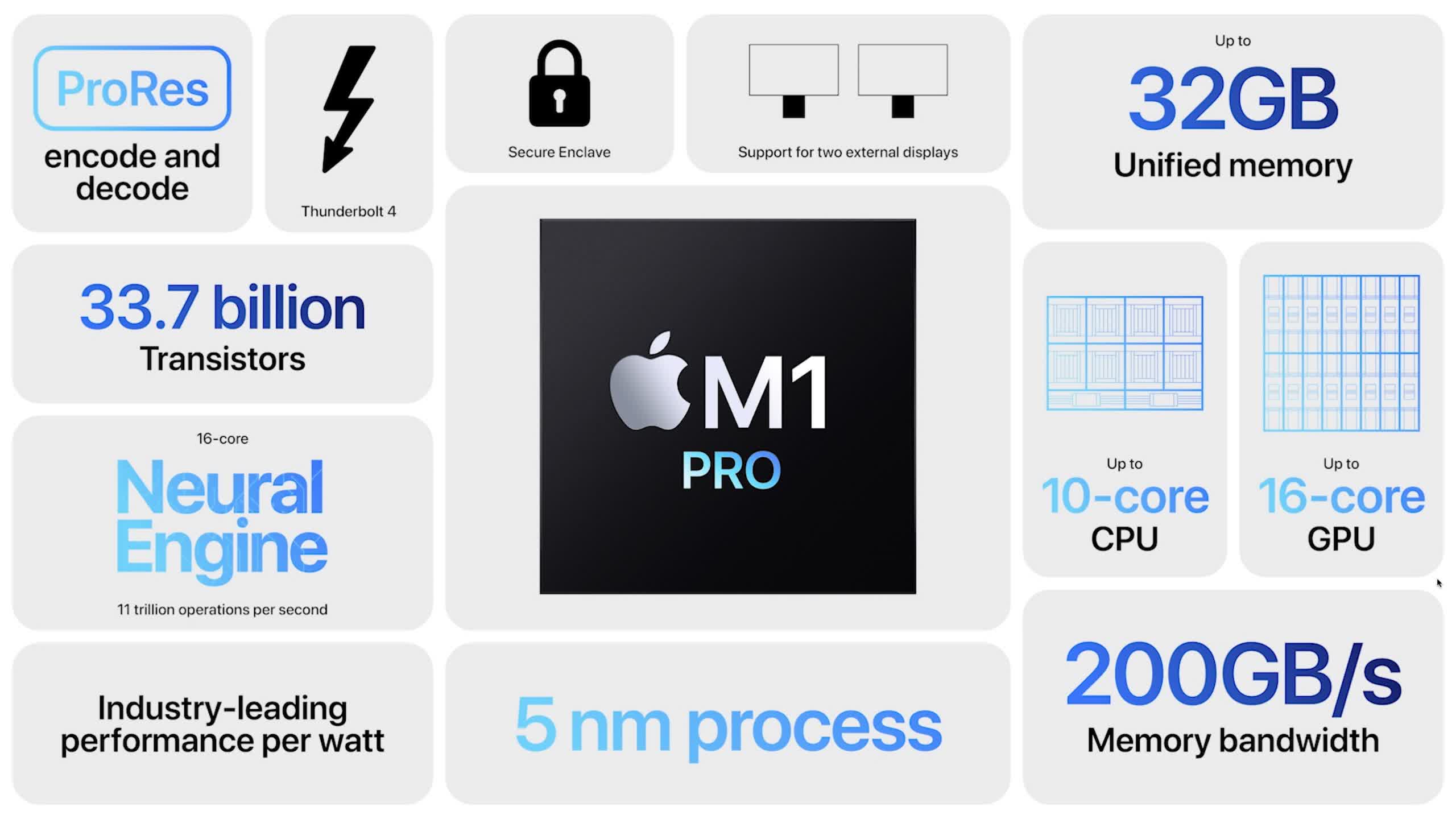
Apple has taken the Nvidia approach to naming the M1 Pro by launching 2 configurations under basically the same proper name. The top-level design packs the full 10-core CPU and 16-core GPU, but the base design cuts that down to just 8 CPU cores and 14 GPU cores. While this is advertised prominently on their production page for the MacBook Pros, Apple doesn't bother differentiating the actual product name across M1 Pro.
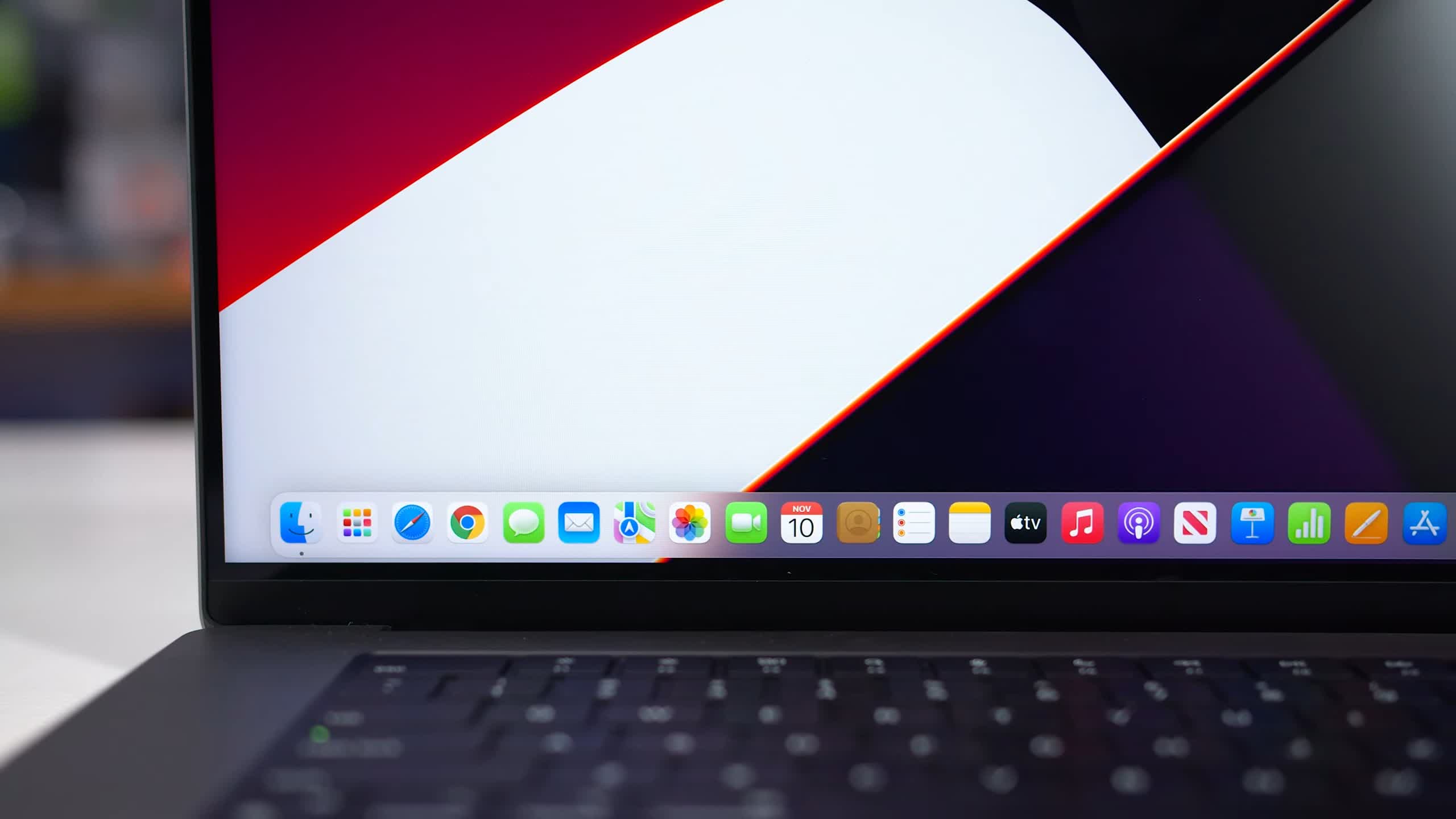
For our testing we purchased a 16-inch MacBook Pro with the full M1 Pro configuration. We also chose 16GB of unified retentiveness to match our existing laptop test information that uses 16GB of RAM, and a 512 GB SSD. Apple'due south upgrades to both RAM and storage are disgustingly expensive, it would accept toll an boosted $600 to bump that to 32GB of retention and 1TB of SSD. You lot can't upgrade these components yourself either, so y'all've got no option but to pay these prices if you demand college capacities, not that you'd await anything different from Apple tree.

For testing today nosotros'll be comparing the M1 Pro to our existing data for AMD and Intel CPUs, which is all power normalized to the default TDPs of those chips. There are, of course, some added challenges which nosotros've spent the last calendar week working through. Namely, non all applications we benchmark are available on macOS. So we're only including cantankerous platform benchmarks with a macOS version, whether that's a native ARM version or an x86 version emulated on Apple Silicon via Rosetta 2.
This immediately introduces a variable in that Windows and macOS versions of apps will work slightly differently, just information technology's the best nosotros tin can do given the circumstances. Let's get to the testing.
Benchmarks
In Cinebench R23 multi-threading, which is a native Apple tree Silicon app, the M1 Pro is slightly faster than the next best CPU that we've tested, the Ryzen 9 5900HX. Across a 10 infinitesimal duration the M1 Pro came out four percentage faster, though it also consumed less power equally nosotros'll talk about subsequently.
The M1 Pro is more than like a 35W class CPU, versus 45W for the 5900HX; the M1 Pro ends up 12 percent faster than AMD'southward all-time 35W CPU in the Ryzen nine 5980HS which is probably more comparable. Apple has an even larger lead on Intel, where the M1 Pro is 14% faster than Intel's all-time silicon at 45W, the Cadre i9-11980HK.

Too of notation is the Intel Cadre i7-10875H. This CPU is most equivalent in multi-thread operation to the 9th-gen Core i9-9980HK that was bachelor in the best 2022 MacBook Pro configurations. The M1 Pro is about threescore percent faster in this benchmark, which is why Apple users are excited about the operation uplift with this new generation using Apple Silicon.

In single thread performance, in that location isn't much separating the M1 Pro and the best CPUs from Intel or AMD. Apple'south fleck is sitting right between the Ryzen ix 5980HS and Cadre i9-11980HK, it's all a bit of a much of a muchness with these CPUs in this workload. Nevertheless performance is more than than 20% faster than the previous Intel CPUs Apple used to use.

Handbrake is available as a native Apple Silicon app on macOS, and shows u.s. CPU-based video encoding using x265. While this app does run natively on the M1 Pro, it benefits significantly on x86-based CPUs from AVX instructions. As such, the M1 Pro isn't that impressive compared to its x86 equivalents, such as the Ryzen 9 5980HS or Core i9-11980HK. While performance isn't bad, the M1 Pro does come in nine per centum backside Intel's best Core i9, and 24% backside AMD's all-time Ryzen nine processor, though Apple's power consumption is lower.

The M1 Pro is a powerful CPU for CPU-based Blender rendering, outperforming the best chips from Intel and AMD. The performance lead over the Ryzen 9 5900HX is small-scale at just 5%, but it'southward a more substantial 23% faster compared to the 11980HK. The principal issue MacBooks face in Blender is that while the app is available for Apple Silicon natively, information technology doesn't support GPU rendering. When using an RTX 3050 with Optix, GPU rendering admittedly obliterates the M1 Pro with operation over 3x faster. Until Blender is updated with GPU support, MacBook Pros are not the best option.

While the M1 Pro so far has traded blows with the all-time x86 CPUs in rendering and encoding tests, Apple Silicon has a massive advantage in code compilation. I should note here that for our Chromium compile, we benchmarked compiling the Windows version on Windows, and the Mac version on macOS, using Google's recommended process for each Bone. Unfortunately, I tried but couldn't get the MacBook Pro to compile the Windows version, even though this is possible on Intel Macs. So this benchmark wasn't as apples-to-apples every bit I'd similar, only it'southward even so a real-earth use instance in my opinion.
In any case the M1 Pro destroys its x86 competition, delivering compile times that are 68% faster than the Ryzen ix 5900HX, the side by side fastest production nosotros've benchmarked. The M1 Pro has an enormous advantage in this workload, especially with its high memory bandwidth that's well over twice that of other laptops in these charts. I suspect these new MacBooks will exist fantabulous for coders.

Matlab is merely available through Rosetta 2 emulation for now, and operation on the M1 Pro suffers equally a effect. The SoC ends up being equivalent to a Ryzen 7 4800H CPU, or an Intel Cadre i7-1165G7, which are decent chips, just not the fastest on the market place today. The M1 Pro is 30 percentage slower than Intel's Cadre i9-11980HK in this app, and then for now you're better off using a modern Windows machine for your engineering work in Matlab.

Microsoft Excel is bachelor natively for Apple Silicon, and our number crunching criterion works only fine. The M1 Pro ends up slightly faster than the best 35W CPU we've tested, the Ryzen 9 5980HS, just can't match the best x86 has to offer in a mobile form gene. The Core i9-11980HK is 23% faster, and the Ryzen ix 5900HX ends up slightly ahead.

The M1 Pro is a creature for 7-Zip pinch, using the native Apple Silicon version compared to the aforementioned benchmark on Windows. The M1 Pro is 11% faster than the i9-11980HK despite using significantly less power in this outburst workload, and a huge 27% faster than the 5900HX which is AMD'south best showing.

However the tables turn when using vii-zip decompression. This criterion loves simultaneous multi-threading on x86 CPUs, and is specially fast on Zen, which leads to a commanding lead over the M1 Pro. This is a weak consequence for Apple Silicon, as it's 32% slower than the Ryzen nine 5900HX and more than in the ballpark of Intel's 10th-generation processors.

PDF exporting is a single-threaded application and Acrobat Pro is only bachelor via Rosetta 2 emulation on macOS. Not to worry though, because the M1 Pro still easily beats its x86 competition with performance in the range of 25% faster than the best AMD or Intel has to offering.

FL Studio is a new addition to our benchmarking and something we've been exploring for some time at present. While there is a native Apple version of the app, unfortunately it runs terribly on the M1 Pro. I quadrupled checked this because I couldn't quite believe it compared to our Windows based systems just information technology's representative of the latest version of the app, exporting the default track. Despite hitting 100% CPU utilization on the MacBook Pro during the rail consign, I reckon something is cleaved with this app and it needs serious work on macOS.

For Adobe Premiere, we've updated our benchmarks to use the latest 2022 version, which runs natively on Apple Silicon. Using the latest version of PugetBench, the overall result looks very impressive for the M1 Pro, outperforming very capable Windows based machines like one with an 11800H and RTX 3070 configuration. This is undoubtedly an first-class effect, simply let's swoop deeper into the subscores.

In terms of exporting, the result from Premiere is similar to what we saw when benchmarking Handbrake earlier, in that the M1 Pro isn't the virtually impressive product. PugetBench uses a mixture of exports, and while the SoC does back up a range of hardware accelerated encoding, Nvidia GPUs are extremely skilful at accelerated encoding and so perform quite well in this benchmark, too.

Where Apple tree is dominant is in live playback, which refers to how smooth playing footage is in the timeline. The M1 Pro with features like hardware accelerated ProRes ends up quite a scrap faster than competing options, with 11th-gen Intel-based machines also performing well due to strong decoding support with their iGPU.


The effects score is pretty good on the M1 Pro too, sitting betwixt the 5900HX and 5800H in this mostly CPU limited score. And then we become to the GPU score where operation is beneath that of the RTX 3050 as expected. I don't really take whatsoever low power GPUs in this criterion yet, and the M1 Pro'southward xvi-core GPU isn't really the equivalent of 80W+ Nvidia GPUs; it ends upwards 23% behind even the RTX 3050 but uses far less power.

While Premiere has a native Apple Silicon version, Subsequently Furnishings does not, and requires the utilize of Rosetta. The M1 Pro still achieves a decent score in PugetBench, outperforming a Ryzen seven 4800H configuration with RTX 2060 graphics, however it falls short of the top Intel-based machines.
This benchmark does utilise the GPU just the end score is heavily based on CPU performance, with the 11800H doing particularly well thanks to its fantabulous single-thread operation. As for Photoshop unfortunately we were unable to benchmark this app every bit the PugetBench tool we use isn't yet compatible with the native Apple Silicon version of Photoshop, and I felt using the Intel version of Photoshop instead would be unfair.

A new add-on to our compute benchmarking is Gigapixel AI epitome upscaling, using Topaz Labs' pop tool. We run this benchmark using GPU acceleration in the fastest possible way, which typically runs very well on Nvidia RTX 30 series GPUs. The M1 Pro has to utilize Rosetta 2 emulation but still performs excellently for what is a low power configuration, sitting betwixt the RTX 3060 and RTX 3050 Ti results. The best Windows car we've tested is 26% faster, but that system is more than equivalent to the M1 Max.

Our final compute benchmark is some other new add-on, Agisoft Metashape which performs photogrammetry to transform even so images into 3D models. This is a GPU accelerated benchmark that goes through the unabridged multi-step process to create a model from sample imagery. We're using the latest beta version of the app which has native Apple Silicon back up.
In this benchmark, the M1 Pro came concluding of the configurations we tested but that's non to be scoffed at because the SoC is only slightly behind much more than ability hungry configurations with larger GPUs. For case, the overall M1 Pro package is only 4% slower than a system with Nvidia'south RTX 3050 running at up to fourscore-95W, despite the entire M1 Pro merely peaking at almost 60W of ability usage in heavy CPU+GPU applications.
Gaming Performance
Next upwards nosotros have gaming functioning in native macOS games and honestly, the macOS gaming ecosystem is pretty dismal. Of the 23 games we benchmark on laptops, only v of them have macOS versions, iv of which worked on the M1 Pro, and none of which have native Apple tree Silicon implementations. This is a pretty similar breakup to my entire game library, of which just sixteen% of games accept macOS versions. That alone means y'all probably shouldn't buy a MacBook for gaming, but nosotros'll test the supported games anyway.

Shadow of the Tomb Raider we specifically benchmark using the final department of the in-game benchmark, not the entire run. In this segment, the M1 Pro ended upward betwixt the GTX 1650 Ti and GTX 1060 6GB in terms of performance, which is probably about expected given its low power nature. This Apple tree Silicon configuration is 22% slower than the full power RTX 3050 from Nvidia, keeping information technology firmly in the entry-level tier of GPUs we've tested.
I should notation hither that the game benchmarking tools available for macOS are extremely rough compared to what is possible on Windows correct now, which has access to powerful software like OCAT. And then while these results are representative of in-game functioning, the accuracy is not where I'd like information technology to exist, merely we just don't have the resource to develop our own macOS FPS counting tools.

The M1 Pro can run Borderlands 3, merely it runs terribly and I don't know whether that's due to the game needing to be emulated via Rosetta 2, or only that the GPU in this chip is weak. Performance is well below even the GTX 1650 Ti and honestly the game is basically unplayable using the Ultra settings combination we tested with.

Metro Exodus is the best case of game operation on the M1 Pro, although I'm not certain how equivalent the game settings are given the macOS version lacks options for tessellation and Hairworks. Only if we assume for a moment that the game is the aforementioned, then the M1 Pro performs very well, slotting between the RTX 3050 and RTX 3050 Ti when playing at 1080p. Unfortunately though, Apple Silicon does non support hardware accelerated ray tracing or DLSS, so its characteristic support in this game is worse than what you'd go on an RTX 3050 equipped laptop.

Lastly we have Civilization VI, which nosotros test using low settings mostly for integrated graphics comparisons. With more powerful GPUs information technology tells us about CPU limited performance. This is another game that runs poorly on the M1 Pro, failing to friction match even the GTX 1650 Max-Q that we take seen in by thin and lite laptops. This game doesn't appear to be optimized at all for Apple Silicon and it may be being high-strung by the fact information technology has to run emulated.
Power Consumption
The concluding area of performance to assess is power consumption, as measured at the wall but excluding idle ability usage. This gives u.s.a. a rough idea of how much power the diverse arrangement components are using under heavy usage, while accounting for differences in displays and so on.
Kickoff upwards nosotros have Cinebench R23 multi-threading, which highlights the keen efficiency of the M1 Pro. Despite slightly outperforming the Ryzen 9 5900HX, power consumption was 13W lower during the sustained long term portion of the benchmark, more in the class of 35W CPUs.

Even more impressive is that a lot of x86 CPUs burst quite high to achieve strong multi-thread performance for a short menses, say in apps like 7-Cypher or Excel. That's not the instance with the M1 Pro, which manages competitive performance in those apps despite sipping just 43W of normalized pinnacle power. The fact Apple can attain the performance they practice without whatever existent sort of boost or turbo clock is very center opening and points to a pattern built for efficiency.
Where Apple tree sees the biggest atomic number 82 on its competitors in efficiency is in Cinebench single threading. Performance hither is roughly equivalent to AMD and Intel'south best laptop CPUs, just power consumption is an order of magnitude lower. Sipping just 7W of power is pretty insane when the latest x86 CPUs are pushing over 20W of power when boosting above four.0 GHz.

This is why the new MacBooks offer such excellent bombardment life, information technology's a dominant lead on its competitors in efficiency when using lightly threaded workloads, assuasive for the best functioning without sacrificing bombardment life.
The M1 Pro is as well exceptionally efficient while gaming. Tiptop power usage during a heavy Shadow of the Tomb Raider department tickled 60W, which was less than half that of our RTX 3050 test systems and just slightly higher than a Ryzen 9 5900HX using its integrated GPU. Performance was lower than the RTX 3050 also in this exam, 24% behind the RTX 3050, but power consumption all up was 55% lower so operation per watt is well in favor of Apple in this compute workload. This is why Apple designed a monolithic SoC with unified memory, it has a lot of benefits from a ability perspective.

Testing the new 16-inch MacBook Pro over the last 2 weeks has been very interesting and a fun challenge to learn more about macOS and its various apps. Even more interesting is how the new M1 Pro performs in real world applications, so allow'due south break it down in what could be a lengthy conclusion.
What We Learned
From a pure functioning perspective, the Apple M1 Pro is an impressive SoC. Performance does vary a bit from application to application, but generally the CPU is very competitive with today's best x86 laptop CPUs from Intel and AMD. In the best cases, where an app tin can truly benefit from the M1 Pro'due south specific features, like its extreme memory bandwidth, the M1 Pro can beat what'due south available on Windows-based devices. At other times, operation is roughly equivalent to CPUs like the Ryzen 9 5900HX and Core i9-11980HK, and in the worst scenarios, similar CPU-based video encoding, information technology tin fall backside. On the whole though, you're definitely getting modern cutting-border performance.
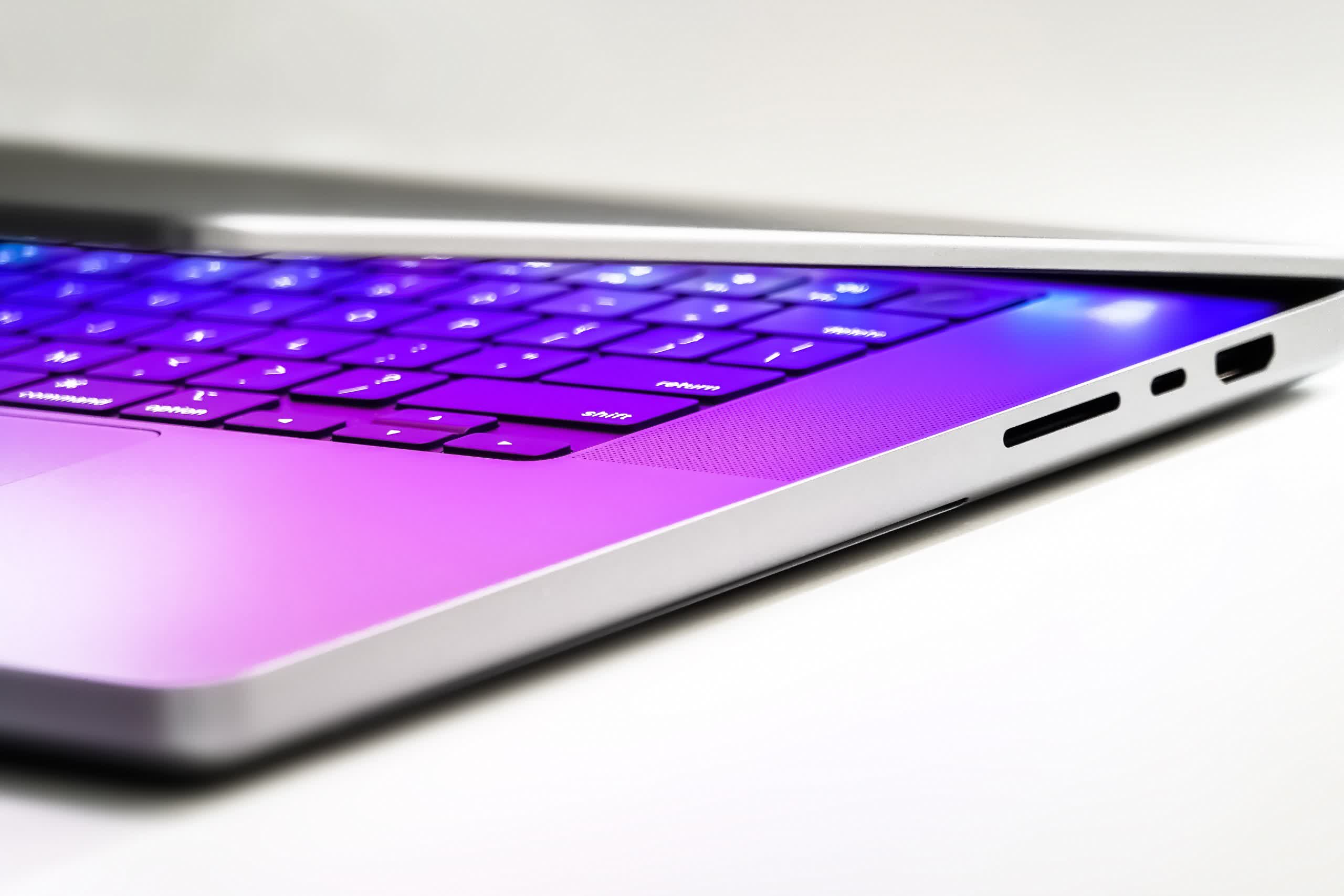
Where Apple can extend its lead farther is when you have specifically tailored workloads that make use of the M1 Pro'south accelerators. Video editing with ProRes acceleration is one example, although export performance isn't quite equally proficient every bit the best x86 systems equipped with an Nvidia detached GPU. If yous take those sorts of workloads, and I imagine a lot of them will be Apple first-party apps like Last Cut or Logic, then you'll run across big gains from using a MacBook Pro with these new M1 chips.
GPU performance is a mixed bag though, I should note nosotros only tested the M1 Pro version with its 16 core GPU, not the total M1 Max which we expect to perform significantly amend. Basically the M1 Pro's GPU is equivalent to a typical lower-power discrete Nvidia GPU in productivity apps (and then, slower than a full power RTX 3050), and quite mediocre in gaming due to a variety of problems including lack of optimization and emulation.
Operation isn't the star of the show, it's the efficiency that elevates the M1 Pro into a grade of its own.
Performance, while adept, isn't the star of the testify though. It's the efficiency that elevates the M1 Pro into a course of its ain. In heavy multi-threaded CPU apps, sure operation may be similar to a Ryzen 9 5900HX, but power consumption is at least 10W lower which makes 35W-class CPUs the most comparable option. Apple but has the all-time performance at the aforementioned power level as today's best x86 designs, a lead which increases in lightly threaded apps, and GPU heavy apps. The whole pattern is built around efficiency and the results are excellent for battery life.
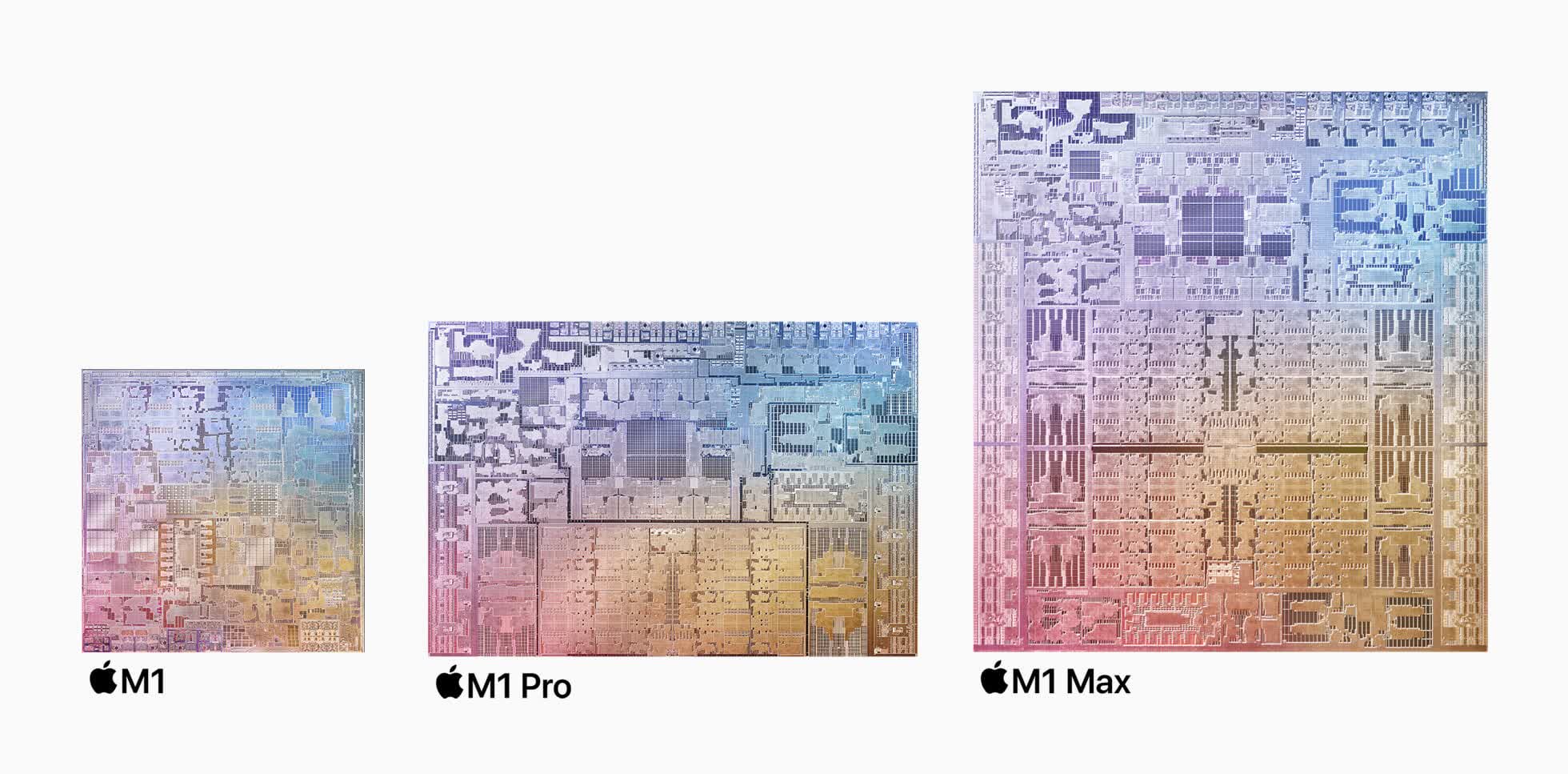
Of class, this is expected given Apple is a full process node ahead of x86 chips: they are using TSMC'southward 5nm, compared to 7nm for AMD, and Intel'southward in-house 10nm SuperFin for their fries. With that sort of advantage, Apple should be ahead, and they are. This gives the M1 Pro ii significant bonuses: functioning doesn't drop to a big degree on bombardment, equally the fries are so efficient they can run at total power without plugging in. And secondly, the new 16-inch MacBook Pro is near silent during nearly workloads, whereas a lot of Windows laptops fire up their fans to jet engine level, especially in apps that utilize a discrete GPU.
... the new sixteen-inch MacBook Pro is near silent during most workloads, whereas a lot of Windows laptops fire up their fans to jet engine level, especially in apps that use a discrete GPU.
While the M1 Pro destroys its competitors when free roaming away from a charger, information technology's a more complicated state of affairs when we're talking about the best operation a laptop tin can offer. Some of the margins where the M1 Pro wins are slim enough that turning an x86 laptop into its "high performance, high ability consumption" mode sees the script flip dorsum to AMD or Intel.
For example, while the M1 Pro is 4% faster than the 5900HX in Cinebench when the 5900HX is configured at 45W, AMD can regain the atomic number 82 when it throws efficiency out the water at 70W or higher, and tin can be upwards of 10% faster.
Where this matters is if y'all're less concerned nigh battery life, and more concerned most having your tasks and workloads completed as before long as possible. Windows systems may still accept the reward in that location, peculiarly so if you get one with a half decent discrete GPU, given the M1 Pro's GPU isn't astonishing and the M1 Max is ludicrously expensive.
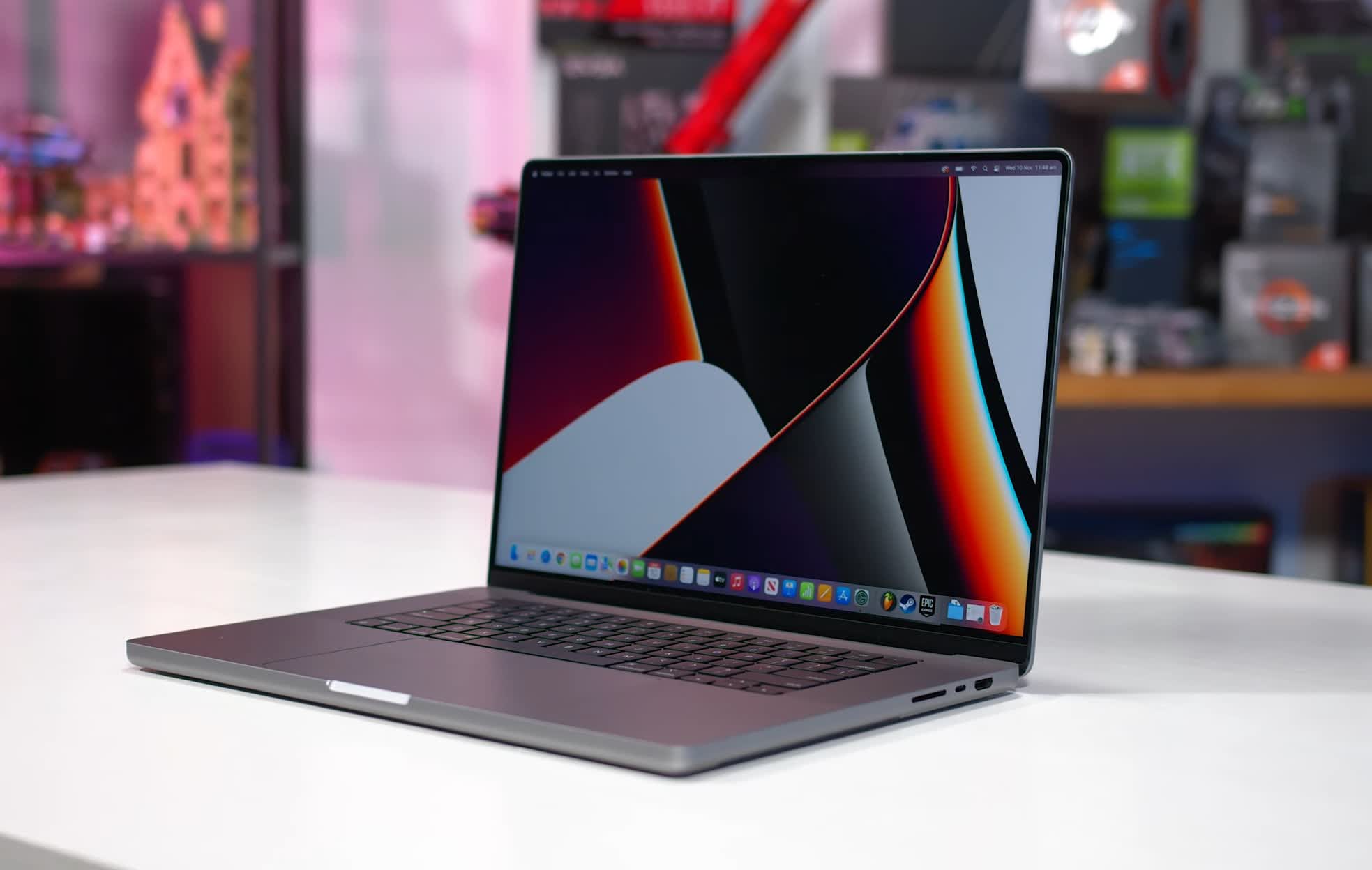
Nosotros're too just not in a position where the M1 Pro in a MacBook is beating or coming shut to a desktop workstation in nearly apps, I know some people are trying to claim this, just when CPUs similar the Ryzen 9 5950X and Core i9-12900K exist, information technology'south merely not true in a full general sense.
However, while the M1 Pro may not be orders of magnitudes faster than what today'southward best Windows systems can achieve (especially on the desktop), it is massively faster than terminal-gen MacBook Pros that use Intel CPUs. The 9th-gen stuff that Apple tree were using previously is slow past modern standards, AMD's Ryzen 4000 series was hands chirapsia it in multi-thread apps in early 2022 and performance has improved further since and so. And then Apple owners are definitely getting a huge upgrade, at to the lowest degree l% more in pure CPU heavy workloads and even more than that in niche apps that benefit from the M1 Pro design.
So the functioning and efficiency of the M1 Pro are very expert, merely I do accept some complaints.
Using the MacBook Pro across a broad range of productivity apps, it yet feels like users are beta testing Apple Silicon. In that location are loads of apps that still aren't updated to natively use the M1 family, despite the starting time M1 powered computers going on sale a year agone. Rosetta 2 works very well, only it costs you lot performance and efficiency. On top of that, some apps that are updated are either missing features (like Blender lacking GPU rendering support), or run badly (such as FL Studio) relative to the same app on Windows. That'southward not neat for a production-focused arrangement where users might need a specific app for their workflow and need those apps to work well for maximum productivity.
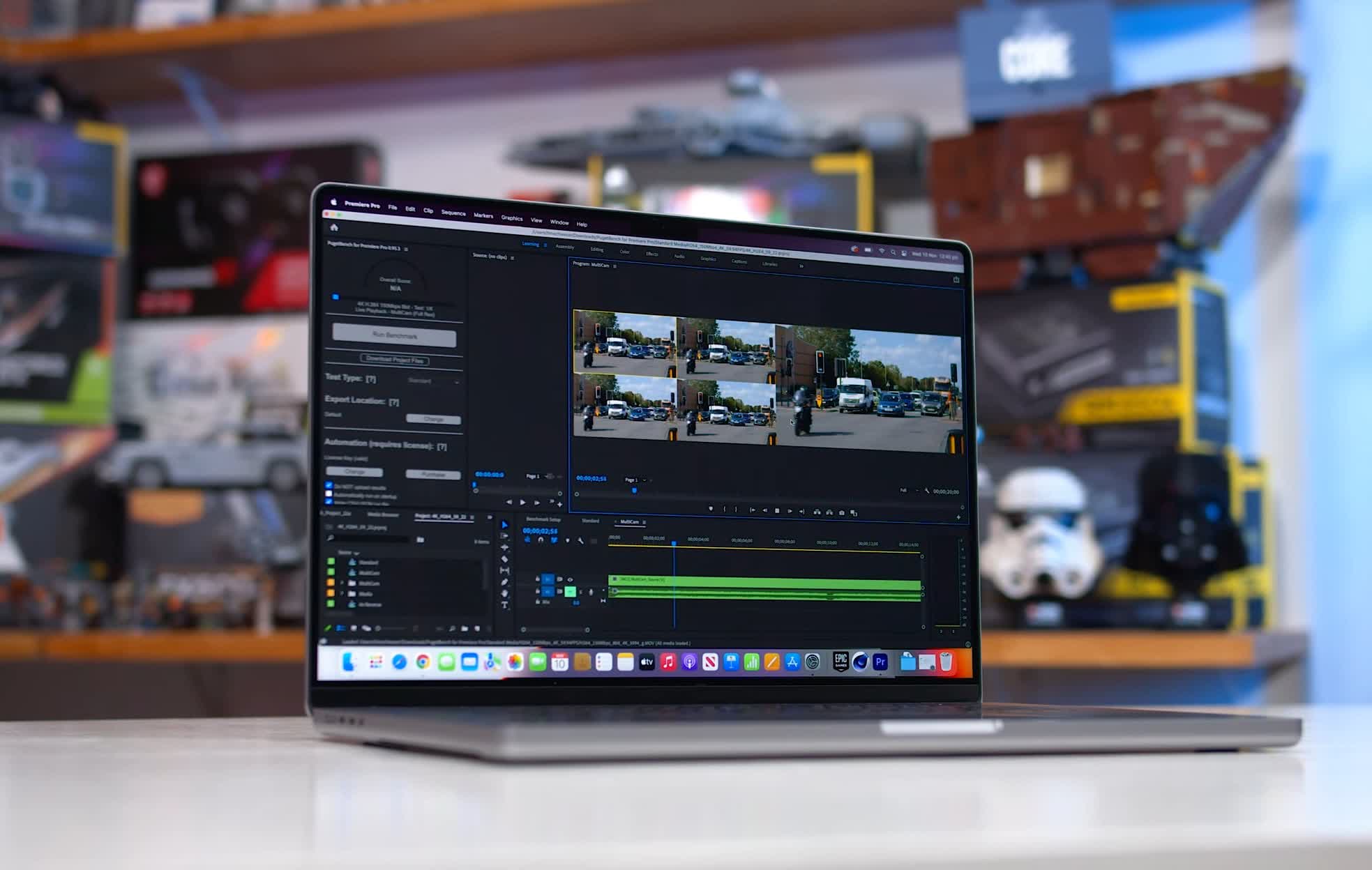
Gaming is also somewhat laughable on macOS, both from a compatibility and performance standpoint. Ane of the best things nigh ownership a high performance Windows laptop for productivity is you can too sneak in some gaming on the side, making those systems pretty versatile given the huge library of supported games. Macs don't accept that versatility, and the M1 Pro is a poor choice for gaming.
Finally, pricing. The total M1 Pro starts in laptops at $2,500, with the full M1 Max costing at to the lowest degree $3,300 (or more if you want decent SSD chapters). Memory and storage upgrades are disgustingly expensive: $400 more to get from 16 to 32GB of RAM, and $200 more to get from a 512GB SSD to 1TB, is ridiculous and fabricated fifty-fifty more terrible due to the lack of user upgradeability. Apple are reaming you for absolutely everything you've got with this release.
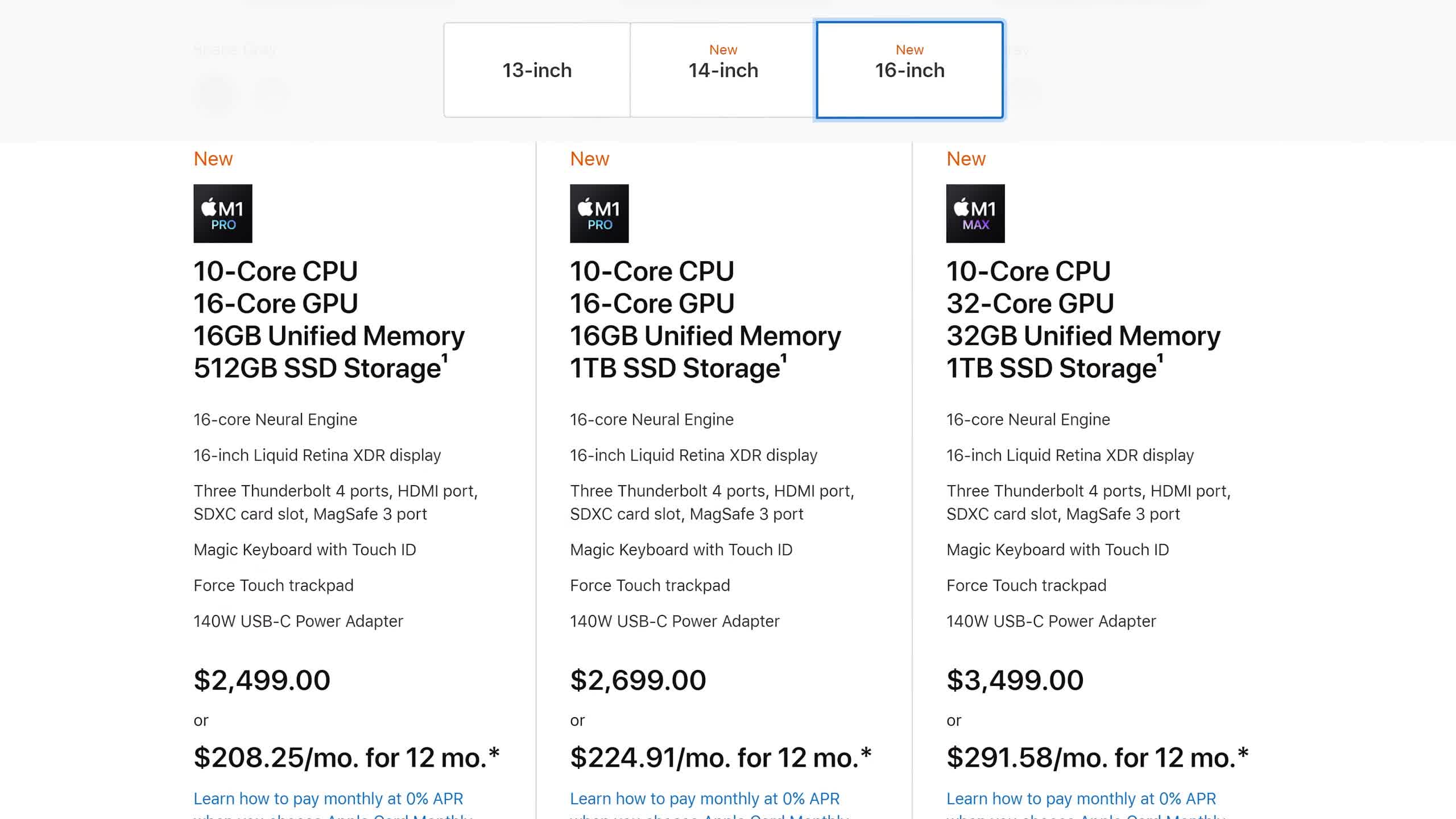
But if we accept the base of operations sixteen-inch M1 Pro configuration that we bought, we're looking at a $ii,500 laptop. You can get some pretty powerful Windows machines for that price, such as the Gigabyte Aero xv OLED or even what I'd grade every bit an expensive laptop like the Razer Blade xv Advanced. Apple tree might be able to justify exorbitant pricing if they were outright faster at everything, but that'southward not the case, especially non with the M1 Pro configuration up against these equivalent models with beefy detached GPUs. And I'1000 not even talking about more than value oriented Windows laptops which are an entirely separate matter.
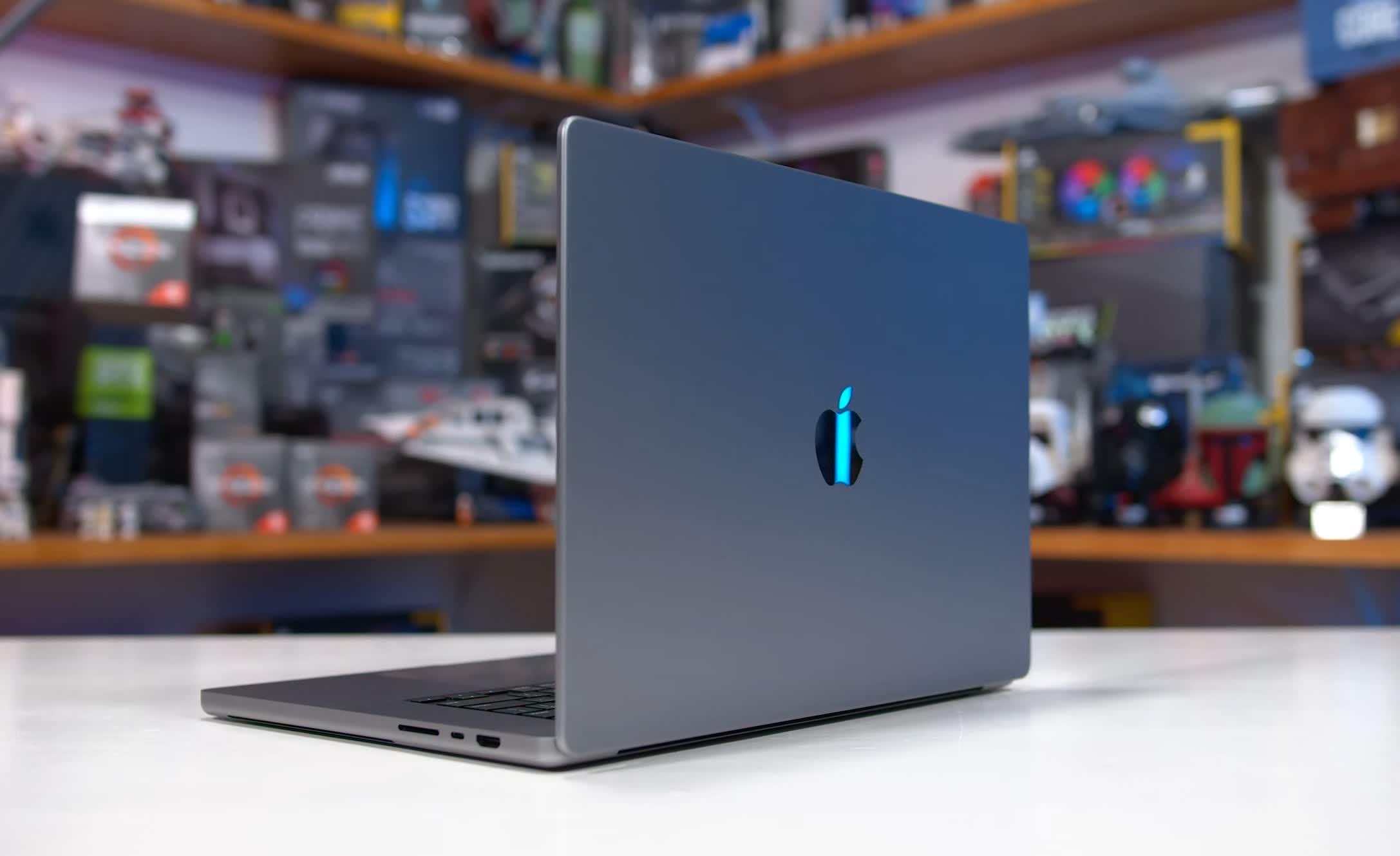
Apple is operating like a monopoly with this pricing, which I guess is fair enough considering the vast majority of MacBook buyers are existing Mac users. From that group, professionals running specific apps that take full advantage of the hardware will rejoice with the M1 Pro. But if Apple tree wants to win Windows users over to Mac, setting pricing so high isn't the way to do it -- for mainstream pricing, the $999 MacBook Air M1 is a prissy organisation, but that'south an entirely different ball game.
Those bug aside, Apple Silicon is certainly in an interesting, compelling position and there is lots of room for x86 competitors to improve, especially on the efficiency front. For example, I'd love to see what AMD could do with a large APU design with a more powerful GPU and the existing efficiency of their chips. There'southward going to be a big fight on their easily and from here hopefully nosotros tin can go on to examination Apple'south latest chips every bit they come out.
Shopping Shortcuts
- Apple MacBook Pro 14 on Amazon
- Apple MacBook Pro xvi on Amazon
- Apple MacBook Air M1 on Amazon
- GeForce RTX 3060 Laptops on Amazon
- Ryzen 9 5900HX Laptops on Amazon
Source: https://www.techspot.com/news/92158-apple-m1-pro-review-soc-vs-intel-amd.html
Posted by: cervantezglanking.blogspot.com


0 Response to "Apple M1 Pro Review"
Post a Comment